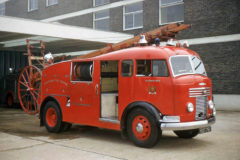A wonderful engine display
Posted by Chris Graham on 28th March 2020
Barry Job pays tribute to Phil Jefferies’ wonderful engine display, which really exemplifies the value of going the extra mile.

A wonderful engine display: Phil Jefferies with his beautifully-presented Crossley Brothers PH1060 engine.
It’s always pleasing to see an exhibit where the owner has made an extra effort to show his engine off to the best advantage. Of course, a lot of owners do this, but one that caught my eye this year was that belonging to Phil Jefferies, who lives near Stafford.
Phil is a member of the Tern Valley Vintage Machinery Trust, and regularly exhibits at the Mill Meece Pumping Station, near Eccleshall; this attractive venue hosts a series of events throughout the year. After many years of not being able to steam the two, magnificent, horizontal compound steam engines, Severn Trent – the pumping station’s owners – has now commissioned the work on repairing the collapsed boiler flues, which should see the engines returned to steam once again during 2020.

Here’s the Crossley Brothers PH1060 engine, s/n 85234, being prepared for the day ahead.
Phil’s engine is a Crossley Brothers PH1060, s/n 85234, that was built at Openshaw, Manchester, in September 1920. It’s a 1,600cc unit and produces 3.25hp. It was sold to the interestingly-named I Dimambio & Sons, of High Street, North Langley Moor, Durham.
They may have been dealers as the engine was soon with Wilkinson & Westmoreland, of Russell Street East, Darlington. The engine’s history is then obscure until it was acquired by Phil. To demonstrate to the public the type of work this engine could be employed to do, it drives a water pump and a generator.

The belt-driven Metropolitan Vickers 12-volt generator is displayed with a lighting board cleverly made up by the owner.
The pump is a Fairbanks, Morse & Co. ‘Typhoon’, that was made in Chicago, Illinois, in about 1920, and delivers 12 gallons per minute while running at 40rpm. The generator is by Metropolitan Vickers Co. Ltd, and came from a colliery where it was used to charge miners’ cap lamps hence, at 1,500rpm, it produces 12 volts. The authentic-looking switchboard has been made by Phil, as have the trolleys; the woodwork is to a very high standard.
At its last outing, at Mill Meece, the magneto was starting to give up the ghost and the engine was reluctant to start. However, the spark plug electrode was wiped with the graphite from a pencil. While I’m not clear about the theory behind this; the graphite evidently did the trick, and the engine was soon running smoothly.

The Fairbanks, Morse & Co ‘Typhoon’ pump dates from around 1920.
The display includes a collection of oil cans and other engineering artefacts. Exhibitors who go the extra mile, with all the effort and expense this entails, must be congratulated for representing our hobby so well.
To subscribe to Stationary Engine magazine, simply click here





